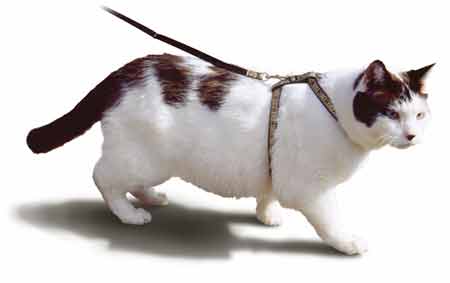 It’s perhaps one of the strangest sights you see – somebody walking their cat via a leash and harness. But if you stop to think about it for a moment, you have to wonder: “Why do I think this is so strange? Dogs do it. Why can’t cats?”
It’s perhaps one of the strangest sights you see – somebody walking their cat via a leash and harness. But if you stop to think about it for a moment, you have to wonder: “Why do I think this is so strange? Dogs do it. Why can’t cats?”
Why can’t cats, indeed.
We’ve been trained to think of dogs as the outdoor walking pets, while cats are either confined to a life indoors, or, on the complete opposite spectrum, free to roam the streets like the wild beasts that they are.
But either of these scenarios might not be ideal for your cat’s well being. As for indoor cats, obesity and boredom might come into play. For free-to-roam outdoor cats, cars, raccoons, other cats, and more all pose a potential risk. So how can you allow your cat to have a bit more fun without dumping him out into the wilderness?
You train him to walk on a leash or harness, of course. But how can you train a cat to accept his new leash or harness if you can’t even get him to stop using your couch as a scratching post?
Start young. Kittens will be more forgiving of new experiences than older cats. Of course, many of you might not have this as an option. Not to fear, older cats can get on board as well.
Get a proper fitting harness. It all begins with a good fit. The leash attachment should be on the back of the harness, not by the neck.
Get your cat accustomed to the leash and harness. Don’t just throw this thing on your cat the day you get it. Let him see it for a few days. Let him smell it. Here’s a good tip: place the leash and harness next to his food for a couple of days.
Next, mock-trials. Before you actually hook your cat up to his harness, pretend like you’re doing it. Get him (and you) used to the type of handling that’s involved when slipping on a harness (including lifting his paws).
It’s go-time, sort of. Once you’re used to what it takes to handle your cat, slip the harness on. But do this during a really pleasurable time for your pet, like when he’s eating a treat. Give him a few treats while you adjust the straps to fit right. Once the harness is good to go, attach the leash. Let your cat run around (in a room where the leash won’t get snagged) with the leash dragging around. Be sure to treat him. When it seems like he’s getting used to his new getup, take the leash and lightly walk him around the house. At first allow him to take you places, but over time you want to incorporate your own directions (gently), as you’ll need to do that outdoors.
Go outside. You have one of three types of cats: a kitten, who’ll probably be overwhelmed and scared of the outdoors at first; an indoor cat who’ll not know what to make of this new world, and will likely be quite scared; or an outdoor cat, who’s ready to bolt the moment the door runs, and can’t understand why something’s holding him back. Regardless, what you need to do before you actually start walking is just “be.” No, not like Zen, more like sit somewhere quiet and safe for a while. That might be all you do the first day, or you may want to go for a short stroll. Over time, if you’re consistent, your cat will become a bona fide leash walker.
The new outdoor cat
Most vets and animal shelters tell you not to let your cat outdoors. It’ll shorten their lives (heck, I rescued my cat after she was found with her tail hanging off, courtesy of a car). But what can be more unnatural for a feline than not spending anytime outside? Do indoor cats have a good life? Of course they do. Do outdoor cats have a lot of fun? They sure do. Is there a way to safely combine both worlds so that your cat can experience the outdoors without putting himself at risk? Of course there is. The answer is the leash and harness.






I agree, and more should try it. Cats who like going out will eventually forget they have a leash on. Our Maine Coon loves leash walks, and it’s a safe way to get out. We even take our kitties camping. See the pics at my blog: http://selfhelpforcats.wordpress.com/2011/06/22/cat-camping-season-officially-opens/ Thanks for the nice article.
Comments are closed.